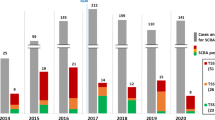Abstract
Purpose
There is increasing reported use of synthetic cannabinoid receptor agonists (SCRA) across Europe. To date, there is limited information on the acute toxicity (harm) related to the use of these products. We describe here a case in which an individual developed convulsions related to the use of the SCRA AM-2201.
Case report
A 20 year old male smoked a "Spice" (SCRA-containing) product called “Black Mamba,” and rapidly after smoking, he had a generalised self-terminating tonic-clonic convulsion. After a 2 h observation period in the Emergency Department (ED), he self-discharged against medical advice. Subsequent analysis of urine collected at the time of presentation to the ED detected metabolites of AM-2201; no other drugs were detected on extensive analytic screening.
Discussion
This is the first case of convulsions related to the use of SCRA described in Europe, and the first case of convulsions related to the use the SCRA AM-2201 confirmed by analysis of biological samples. It is important for emergency physicians, clinical toxicologists and clinical pharmacologists managing those presenting with acute toxicity related to the use of SCRA to analytically confirm the exact compound(s) involved, to enable accurate description of the acute toxicity associated with individual SCRA.
Similar content being viewed by others
References
Home Office Statistical Bulletin (2012) Drug Misuse Declared: Findings from the 2010/11 British Crime Survey Available from: http://www.homeoffice.gov.uk/publications/science-research-statistics/research-statistics/crime-research/hosb1211/hosb1211?view=Binary [Last accessed 19th March]
Wood DM, Ramsey J, Dargan PI (2008) Detecting novel and emerging recreational drugs on the ‘club scene’. Irish Psychiatrist 9:223–228
Wood DM, Measham F, Dargan PI (2012) ‘Our Favourite Drug’: Prevalence of use and preference for mephedrone in the London night-time economy 1 year after control. J Subs Use In press
Measham F, Wood DM, Dargan PI, Moore K (2011) The rise in legal highs: prevalence and patterns in the use of illegal drugs and first and second generation ‘legal highs’ in south London gay dance clubs. J Subs Use 16:263–272
Dick D, Torrance C (2010) Drugs survey. MixMag 225:44–53
EMCDDA Annual Report 2011: Annual report on the state of the drugs problem in Europe. Available from: http://www.emcdda.europa.eu/attachements.cfm/att_143743_EN_EMCDDA_AR2011_EN.pdf [Last accessed 19th March 2012]
Wells DL, Ott CA (2011) The “new” marijuana. Ann Pharmacothe 45:414–417
European Monitoring Centre for Drugs and Drug Addiction. Understanding the “Spice” Phenomenon (2009) Available from: http://www.emcdda.europa.eu/attachements.cfm/att_80086_EN_Spice%20Thematic%20paper%20%E2%80%94%20final%20version.pdf [Last accessed 19th March 2012]
Dargan PI, Hudson S, Ramsey J, Wood DM (2011) The impact of changes in UK classification of the synthetic cannabinoid receptor agonists in ‘Spice’. Int J Drug Policy 22:274–277
Wood DM, Dargan PI (2012) Novel psychoactive substances: how to understand the acute toxicity associated with the use of these substances. Ther Drug Monitor In press
Rosenbaum C, Carreiro S, Babu K (2012) Here today, gone tomorrow…and back again? A review of herbal marijuana alternatives (K2, Spice), synthetic cathinones (Bath Salts), kratom, salvia divinorum, methoxetamine, and piperazines. J Med Toxicol 8:15–32
Lapoint J, James LP, Moran CL, Nelson LS, Hoffman RS, Moran JH (2011) Severe toxicity following synthetic cannabinoid ingestion. Clin Toxicol (Phila) 49:760–764
Simmons J, Cookman L, Kang C, Skinner C (2011) Three cases of “spice” exposure. Clin Toxicol (Phila) 49:431–433
Schneir A, Baumbacher T (2012) Convulsions associated with the use of a synthetic cannabinoid product. J Med Toxicol 8:62–64
Di Marzo V, Bifulco M, De Petrocellis L (2004) The endocannabinoid system and its therapeutic exploitation. Nat Rev Drug Discov 3:771–784
Deluca P, Shifano F, Davey Z, Corazza O, di Furia L, Farre M et al (2009) Spice report by the psychonaut web mapping research project. Institute of Psychiatry, King’ s College London, London
Vardakou I, Pistos C, Spiliopoulou C (2010) Spice drugs as a new trend: mode of action, identification and legislation. Toxicol Lett 197:157–162
Simmons JR, Skinner CG, Williams J, Kang CS, Schwartz MD, Wills BK (2011) Intoxication from smoking “spice”. Ann Emerg Med 57:187–188
Banerji S, Deutsch CM, Bronstein AC (2010) Spice ain’t so nice. Clin Toxicol 48:632
Bebarta VS, Varney S, Sessions D et al (2010) Spice: a new “legal” herbal mixture abused by young active duty military personnel. Clin Toxicol 48:632
Simmons J, Cookman L, Kang C, Skinner C (2011) Three caes of “spice” exposure. Clin Toxicol 49:431–433
Schneir AB, Cullen J, Ly BT (2011) “Spice” girls: synthetic cannabinoid intoxication. J Emerg Med 40:296–299
Vearrier D, Osterhoudt KC (2010) A teenager with agitation. Pediatr Emerg Care 26:462–464
Canning JC, Ruha A-M, Pierce R, Torrey M, Reinhart SJ (2010) Severe gi distress after smoking JWH-018. Clin Toxicol 48:618
Muller H, Sperling W, Kohrmann M et al (2010) The synthetic cannabinoid spice as a trigger for an acute exacerbation of cannabis induced recurrent psychotic episodes. Schizophr Res 118:309–310
Sobolevsky T, Prasolov I, Rodchenkov G (2010) Detection of JWH-018 metabolites in smoking mixture post administration urine. Forensic Sci Int 200:141–147
Möller I, Wintermeyer A, Bender K, Jübner M, Thomas A, Krug O, Schänzer W, Thevis M (2011) Screening for the synthetic cannabinoid JWH-018 and its major metabolites in human doping controls. Drug Test Anal 3:609–620
Conflicts of interest
D.M.W. and P.I.D. have acted as scientific advisors to the UK Advisory Council on the Misuse of Drugs (ACMD) and the European Monitoring Centre for Drugs and Drug Abuse (EMCDDA).
Author information
Authors and Affiliations
Corresponding author
Rights and permissions
About this article
Cite this article
McQuade, D., Hudson, S., Dargan, P.I. et al. First European case of convulsions related to analytically confirmed use of the synthetic cannabinoid receptor agonist AM-2201. Eur J Clin Pharmacol 69, 373–376 (2013). https://doi.org/10.1007/s00228-012-1379-2
Received:
Accepted:
Published:
Issue Date:
DOI: https://doi.org/10.1007/s00228-012-1379-2




